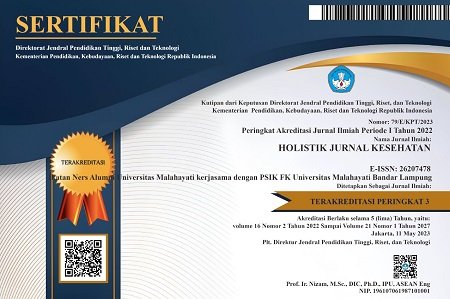Pengaruh paparan sinar matahari pada penderita diabetes melitus tipe 2
Abstract
Background: The increase in cases of Diabetes Mellitus at a young age is a serious problem and must be treated as early as possible because it will have an effect on decreasing the quality of life in the future. Recently, many studies have reported that vitamin D levels in DM patients are very low. Sources of vitamin D come from food and also from the biosynthesis of pro-vitamin D in the skin with the help of sunlight / UVB. Trends in behavior to avoid UVB rays such as the use of closed clothing and activities/work indoors are thought to be related to the incidence of low levels of vitamin D which will have an effect on increasing cases of uncontrolled DM.
Purpose: To analyze the relationship between habitual avoidance of sun exposure and the incidence of elevated blood glucose in DM patients.
Method: An analytical survey research with a case-control approach. The population in this study were all type 2 DM patients who went to the internal medicine polyclinic of the Bintang Amin Hospital in the period January 2022. The case samples were DM patients whose (RBG test) was above 200 mg/dL (uncontrolled DM) and the control group were DM patients whose (RBG test) was below 200 mg/dL (controlled DM). The total sample was 88 patients with 44 case samples and 44 control samples. Data were analyzed using non-parametric statistical test: chi square test.
Results: There was a significant relationship between the incidence of uncontrolled DM with the habit of being active indoors (0.003), wearing closed clothes (0.001), working outside the home (0.03), age (0.01) and gender (0.003).
Conclusion: The more often a person avoids sun exposure: active indoors and always wears long/closed clothes for a long time, the higher the (RBG test) level, thus increasing the risk of developing uncontrolled diabetes. It is recommended to spend 5-30 minutes a week 2-3 times to give the body's skin a chance to be exposed to sunlight/UVB, this is important to maintain vitamin D biosynthesis.
Keywords: Sun exposure; Vitamin D; Patients; Diabetes mellitus
Pendahuluan: Peningkatan kasus DM pada usia muda merupakan masalah serius dan harus ditangani sedini mungkin, karena akan berefek pada penurunan kualitas hidup penderitanya di masa yang akan datang. Akhir-akhir ini, banyak riset yang melaporkan bahwa, kadar vitamin D pasien DM sangat rendah. Sumber vitamin D selain dari makanan, juga berasal dari biosintesis pro vitamin D di kulit dengan bantuan sinar matahari/UVB. Adanya trends prilaku menghindar sinar UVB seperti pengunaan pakaian panjang/tertutup dan beraktiivitas/bekerja di dalam ruangan diduga berhubungan dengan kejadian rendahnya kadar vitamin D yang akan berefek pada peningkatan kasus DM tidak terkontrol.
Tujuan: Untuk memperlajari hubungan kebiasaan menghindar dari sinar matahari dengan kejadian peningkatan glukosa darah pada pasien DM.
Metode: Penelitian survey analitik dengan pendekatan case control. Adapun populasi pada penelitian ini adalah semua pasien DM tipe 2 yang berobat ke poli penyakit dalam RSPBA pada periode Januari 2022. Adapun yang menjadi sampel kasus adalah pasien DM yang glukosa darah sementara/GDS nya di atas 200 mg/dL (DM tidak terkontrol) dan kelompok kontrol adalah pasien DM yang GDSnya di bawah 200 mg/dL (DM terkontrol). Adapun total sampel ada 88 pasien dengan 44 orang sampel kasus dan 44 sampel control. Data yang dikumpulkan, dianalisis dengan menggunakan uji statistic non parametric: chi square.
Hasil: Didapatkan hubungan yang bermakna antara kejadian DM tidak terkontrol dengan kebisaan berakatifitas di dalam ruangan (0.003), pengunaan pakaian panjang/tertutup (0.001), bekerja di luar rumah (0.03), usia (0.01) dan jenis kelamin (0.003).
Simpulan: Semakin sering seseorang menghindar paparan sinar matahari: beraktivitas di dalam ruangan serta selalu menggunakan baju panjang/tertutup dalam jangka waktu lama, akan semakin meningkatkan kadar GDS sehingga meningkatkan pula resiko menjadi DM tidak terkontrol. Direkomendasikan untuk meluangkan waktu 5-30 menit seminggu 2-3 kali untuk memberi kesempatan kulit tubuh terpapar sinar matahari/UVB, hal ini penting untuk menjaga agar biosintesis vitamin D tetap terjaga.
Keywords
References
Al-Yatama, F. I., Alotaibi, F., Al-Bader, M. D., & Al-Shoumer, K. A. (2019). The Effect of Clothing on Vitamin D Status, Bone Turnover Markers, and Bone Mineral Density in Young Kuwaiti Females. International Journal of Endocrinology, 2019. https://doi.org/10.1155/2019/6794837
Alfredsson, L., Armstrong, B. K., Allan Butterfield, D., Chowdhury, R., de Gruijl, F. R., Feelisch, M., & Young, A. R. (2020). Insufficient sun exposure has become a real public health problem. International Journal of Environmental Research and Public Health, 17(14), 1–15. https://doi.org/10.3390/ijerph17145014
American Diabetes Association. (2009). Diagnosis and classification of diabetes mellitus. Diabetes care, 32(Supplement_1), S62-S67.
Cashman, K. D., Dowling, K. G., Škrabáková, Z., Gonzalez-Gross, M., Valtueña, J., De Henauw, S., & Kiely, M. (2016). Vitamin D deficiency in Europe: Pandemic? American Journal of Clinical Nutrition, 103(4), 1033–1044. https://doi.org/10.3945/ajcn.115.120873
Castellano-Guerrero, A. M., Guerrero, R., Ruiz-Aranda, D., Perea, S., Pumar, A., Relimpio, F., & Martínez-Brocca, M. A. (2020). Gender differences in quality of life in adults with long-standing type 1 diabetes mellitus. Diabetology and Metabolic Syndrome, 12(1), 1–7. https://doi.org/10.1186/s13098-020-00571-x
Daryabor, G., Atashzar, M. R., Kabelitz, D., Meri, S., & Kalantar, K. (2020). The Effects of Type 2 Diabetes Mellitus on Organ Metabolism and the Immune System. Frontiers in Immunology, 11(July). https://doi.org/10.3389/fimmu.2020.01582
Haimi, M., & Kremer, R. (2017). Vitamin D deficiency/insufficiency from childhood to adulthood: Insights from a sunny country. World Journal of Clinical Pediatrics, 6(1), 1. https://doi.org/10.5409/wjcp.v6.i1.1
Hall, J. E. (2015). Guyton and Hall review physiology (13th ed.). Philadelphia: Sauders-Elsevier.
Hataikarn Nimitphong, & Michael F.Holick. (2013). Prevalence of Vitamin D Deficiency in Asia Vitamin D status and sun exposure in Southeast Asia. Dermato-Endocrinology, 5(1), 34–37.
Hermawan, D. (2021). Manfaat Vitamin D pada Era Pandemi Covid-19. Yogyakarta, Indonesia: Penerbit Buku Andi. Retrieved from https://books.google.co.id/books?id=kNA3EAAAQBAJ&printsec=frontcover&hl=id&source=gbs_ge_summary_r&cad=0#v=onepage&q&f=false
Hermawan, D., & Andoko. (2019). Hubungan Antara Kadar Vitamin D dalam Darah dengan Tekanan Darah Usia Lanjut di Natar Lampung Selatan. Jurnal Keperawatan Sriwijaya, 6(1), 1–8.
Hermawan, D., Muhani, N., Sari, N., Arisandi, S., Widodo, S., Lubis, M. Y., & Firdaus, A. A. (2020). Mengenal Obesitas. Yogyakarta: Penerbit Buku Andi. Retrieved from https://books.google.co.id/books?id=mY_5DwAAQBAJ&printsec=frontcover&hl=id&source=gbs_atb#v=onepage&q&f=false
Kementerian Kesehatan Republik Indonesia. (2018). Riskesdas 2018. Jakarta, Indonesia: Sekretariat Litbang Kesehatan Kemenkes.
Kevin D. Cashman. (2020). Vitamin D Deficiency: Defining, Prevalence, Causes, and Strategies of Addressing. Calcif Tissue Int, 106, 14–29. https://doi.org/https://doi.org/10.1007/s00223-019-00559-4
Kostoglou-Athanassiou, I., Athanassiou, P., Gkountouvas, A., & Kaldrymides, P. (2013). Vitamin D and glycemic control in diabetes mellitus type 2. Therapeutic Advances in Endocrinology and Metabolism, 4(4), 122–128. https://doi.org/10.1177/2042018813501189
Lemieux, P., John Weisnagel, S., Caron, A. Z., Julien, A. S., Morisset, A. S., Carreau, A. M., … Gagnon, C. (2019). Effects of 6-month Vitamin D supplementation on insulin sensitivity and secretion: A randomised, placebo-controlled trial. European Journal of Endocrinology, 181(3), 287–299. https://doi.org/10.1530/EJE-19-0156
Longo, M., Bellastella, G., Maiorino, M. I., Meier, J. J., Esposito, K., & Giugliano, D. (2019). Diabetes and aging: From treatment goals to pharmacologic therapy. Frontiers in Endocrinology, 10(FEB). https://doi.org/10.3389/fendo.2019.00045
Mendes, M. M., Hart, K. H., Botelho, P. B., & Lanham-New, S. A. (2018). Vitamin D status in the tropics: Is sunlight exposure the main determinant? Nutrition Bulletin, 43(4), 428–434. https://doi.org/10.1111/nbu.12349
Michael F Holick. (2017). The vitamin D deficiency pandemic: Approaches for diagnosis, treatment and prevention. Rev Endocr Metab Disord, 18(2), 153–165. https://doi.org/0.1007/s11154-017-9424-1
Mitri, J., & Pittas, A. G. (2014). Vitamin D and Diabetes. Contemporary Endocrinology, 43(1), 135–149. https://doi.org/10.1016/j.ecl.2013.09.010
DOI: https://doi.org/10.33024/hjk.v16i1.6304
Refbacks
- There are currently no refbacks.
Copyright (c) 2022 Holistik Jurnal Kesehatan

This work is licensed under a Creative Commons Attribution-NonCommercial 4.0 International License.














